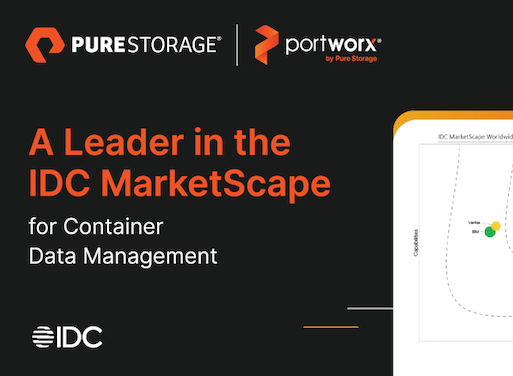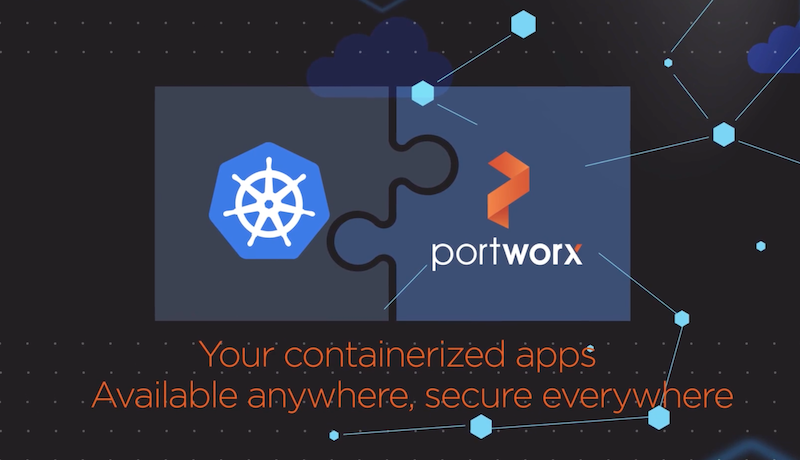Simplify Kubernetes Storage Management at Scale
Portworx storage services provides elastic scalability, industry-leading availability, and self-service access to storage for Kubernetes environments. Integrated storage management includes rule-based automation, thin-provisioning allocation and flexibility for multi-cloud, hybrid-cloud and on-premises.
- Consistent, secure and reliable storage layer for any infrastructure
- Migrate applications anywhere
- Self-service access
The Kubernetes Storage Platform
Automate Storage Management
Portworx storage is a built-for-Kubernetes service that offers flexible and scalable persistent storage for applications in production.
- Aggregates and pools storage for consumption in a simple, centralized platform.
- Provides thin provisioning to right-size provisioned storage, resulting in cost savings.
- Uses automated capacity management with intelligent rule-based dynamic growth of persistent volumes and storage pools.
- Allows users to dynamically provision their own volumes with capabilities based on defined parameters.
- Offers on-demand scalability to deploy storage only when and where needed.
Application Migration Anywhere
Run Portworx in any environment—cloud, on-premises, or hybrid cloud—for flexibility across deployments while offering a cloud-like experience with self-service access to provision storage.
Simple application migration makes it easy to move any application across clusters, racks, or clouds, all while ensuring a secure migration with application-consistent snapshots and backup to any cloud.
Disaster Recovery and Business Continuity
Meet compliance needs and application SLAs with synchronous and asynchronous disaster recovery. Portworx offers zero Recovery Point Objective (RPO) and short Recovery Time Objective (RTO) disaster recovery for mission-critical applications, ensuring quick recovery and limited application downtime.
Protect any applications on Kubernetes from extended downtime with multiple options for disaster recovery and enable failover within minutes.

Analyst Report
IDC MarketScape Names Pure Storage a Leader in Container Data Management
Portworx Platform Services
Backup Services
Protect mission critical data with self-service backup. Container & application aware. Backup & migrate data anywhere, between clusters, clouds & regions.
Learn MoreDisaster Recovery
Deliver availability & recoverability ensuring business continuity with zero RPO for Kubernetes. Multi-site synchronous metro & asynchronous WAN replication.
Learn MoreDatabase Services
Simplify and automate the deployment of Mongo, Elastic, Kafka, Postgres, Kafka and Cassandra. Empower developers with self-service Day 1 & Day 2 data ops.
Learn MoreDevOps Services
Integrated with GitOps & CICD pipelines. Manage storage services with a single-pane interface to provide development teams with self-service capabilities.
Learn MoreAdditional Capabilities
Containers-as-a-Service
Containers-as-a-Service providers often don’t feature the enterprise-grade requirements many organizations need. Learn more about these providers and how to fill the gaps.
Read moreSoftware-as-a-Service Support
Power your SaaS application(s) on Kubernetes with a platform that scales your data services with limited complexity, all while meeting compliance requirements.
Read moreBig Data Workloads
Containerize data processing workloads to quickly deploy performant, scalable, and optimized storage.
Read moreBusiness Continuity and Disaster Recovery
Learn the best practices for disaster recovery and business continuity for Kubernetes applications.
Read moreTop Resources
Frequently Asked Questions
How secure is Portworx storage services?
Security is essential for the enterprise, and containerized workloads are no different. Portworx provides cluster-wide encryption and role based access controls (RBAC) that can be integrated into your own authentication system to help prevent unauthorized access to sensitive data.
Bring-your-own-key (BYOK) encryption gives you full control over the security of your encryption within Portworx.
Granular RBAC helps regulate access to specific Kubernetes resources based on pre-defined roles, so you don’t have to worry about anyone getting unauthorized access to data or operations outside of their scope.
I only have a small deployment of Kubernetes applications. Is there a no-cost or low-cost way to use Portworx storage services?
Portworx storage services does offer a freemium tier with Portworx Essentials, providing many of the enterprise-grade features on the full product without any cost involved. It provides all the essential functionality for any organization to run their Kubernetes applications in production.
Portworx Essentials does limit the number of nodes, volumes, and storage per cluster in a single deployment of Portworx storage services. However, you can upgrade at any time to Portworx Enterprise.
Why not try a CSI for Kubernetes storage?
CSI (container storage interface) is a plugin that connects traditional storage systems to containers. These connectors were purpose-built to allow legacy storage to be used in Kubernetes, so they can be the cause of multiple issues when implemented instead of a cloud-native solution.
Using CSIs can lead to poor performance for applications and low quality of service for developers due to control planes requiring calls to storage systems which live outside of Kubernetes. Host failures when using CSI connectors to legacy storage often results in long-duration reattachment of volumes to a surviving Kubernetes node, resulting in application timeouts and downtime.
The connector based approach also increases vendor lock-in since data is tied to a specific storage system supported by the vendor, making migrations and consistent deployments across multiple platforms or locations much more difficult.



